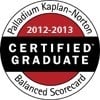Strategic management maturity is not just a fancy phrase tossed around in boardrooms, it represents the organization’s ability to consistently formulate, execute, and adapt its strategy to achieve its goals.
.png?width=648&height=492&name=Infographic%20-%20visual%20selection(1).png)
Need Help with Assessing Your Strategic Management Maturity
Understanding the Different Levels of Strategic Management Maturity
Much like climbing a ladder, strategic management maturity involves ascending distinct levels. Each level represents a stage of development with its own characteristics and challenges. Understanding where your organization currently stands on this ladder can provide a roadmap for progress.
Level 1: Ad Hoc and Static
Organizations at this level often operate in a reactive manner. Imagine a ship without a rudder—tossed about by immediate demands without a clear direction. There’s little to no formal strategic planning and efforts are often confined to tactical or operational issues. A study published on Zenodo underscores the dangers of this reactive approach, emphasizing that it inhibits growth and limits organizational effectiveness.
Level 2: Reactive
In this stage, organizations begin recognizing the need for strategic management. However, it's sporadic, inconsistent, and largely driven by events rather than a proactive approach. The Balanced Scorecard Institute (BSI) highlights the challenges this level presents in its Strategic Management Maturity Model. They indicate organizations at this level might measure performance, but it’s often used punitively rather than as a tool for improvement. This reactive mindset prevents organizations from getting ahead of the curve and proactively capitalizing on opportunities.
Level 3: Structured and Proactive
This is where things begin to take shape. Organizations start establishing formal structures, implementing regular strategic planning, and aligning activities with goals and using formal project management approaches. According to a BPTrends report, companies embracing structured processes are more likely to identify optimization opportunities, a critical element of successful strategic management.
Level 4: Managed and Focused
Level 4 is characterized by strategy becoming the driving force. Decisions are made through a strategic lens and a culture of accountability starts permeating the organization. Leaders actively engage employees, creating a sense of shared ownership in achieving goals. A Gartner study on Business Process Management (BPM) highlights the importance of a focused approach.
Level 5: Continuous Improvement
Achieving the pinnacle of strategic management maturity, organizations here exhibit an unwavering commitment to continuous improvement. Strategic thinking is deeply ingrained in their DNA. Planview’s Innovation Maturity Model emphasizes that continuous improvement is directly linked with successful innovation and adaptability, allowing businesses to thrive in ever-evolving markets. From their initial strategic goals, they relentlessly analyze their progress and adapt their strategic planning and management processes accordingly.
Assessing Your Organization’s Strategic Management Maturity
Determining your organization’s current level of strategic management maturity is crucial to charting a path towards improvement. Various models, including the widely recognized Balanced Scorecard Institute's model, provide frameworks for conducting self-assessments.
These models typically involve evaluating different dimensions of strategic management. For instance, leadership plays a pivotal role as highlighted in a research article in the International Journal of Operations & Production Management. They emphasize that the way leaders communicate, delegate, and empower significantly influences the organization’s strategic success. Assessing leadership effectiveness is one crucial aspect of evaluating strategic management maturity.
Other critical dimensions commonly assessed in these models include:
- Organizational Culture & Values
- Strategic Thinking & Planning
- Alignment of Resources and Efforts
- Performance Management & Measurement
- Process Improvement & Innovation
- Sustainability of Strategic Initiatives
By thoroughly evaluating these dimensions, organizations gain a comprehensive understanding of their strategic management maturity.
The Benefits of Advancing Strategic Management Maturity
Why embark on this journey toward greater strategic management maturity? This effort yields substantial rewards:
Improved Goal Alignment
Organizations operating at higher levels demonstrate better alignment between their strategic objectives and day-to-day operations. Everyone in the organization, from senior leadership to individual contributors, understands their role in achieving common goals. This alignment minimizes wasted effort and resources while maximizing efficiency. It’s akin to having everyone rowing the boat in the same direction—effort translates into meaningful progress and impact.
Enhanced Decision-Making
As your strategic management maturity advances, you’ll likely witness more data-driven and strategic decision-making throughout the organization. Instead of reacting to problems, you can proactively anticipate and mitigate them.
Increased Adaptability & Resilience
In today’s volatile business landscape, being able to swiftly adapt to change is crucial. With each level of strategic management maturity, your ability to foresee, embrace, and leverage change becomes more robust.
Conclusion
Strategic management maturity is a voyage, not a destination. It's about continuously evolving and fine-tuning your processes, fostering a culture that embraces strategic thinking. Organizations that commit to this journey unlock a treasure trove of advantages, setting themselves up for enduring success in an increasingly complex and competitive world. As you continue along your path of strategic management maturity, always remain adaptable, learning, and refining your approach to drive sustained growth.
FAQs About Strategic Management Maturity
What are the 5 stages of strategic management?
The five stages of strategic management maturity are:
- Ad Hoc & Static
- Reactive
- Structured & Proactive
- Managed & Focused
- Continuous Improvement
What are the 5 Ps of strategy in strategic management?
The 5 Ps of strategy are: Plan, Ploy, Pattern, Position, and Perspective. This framework was introduced by Henry Mintzberg. They encourage looking at strategy from multiple angles. These angles provide a more comprehensive understanding, moving beyond simply viewing it as a plan.
What is management maturity?
Management maturity refers to the organization’s ability to effectively manage its people, processes, and resources to achieve strategic objectives. It encompasses factors such as leadership, organizational culture, and a systematic approach to problem-solving, risk management, and continuous improvement efforts. It goes beyond just strategic management, impacting overall organizational effectiveness.
Conclusion
Achieving a high level of strategic management maturity takes time, commitment, and continuous effort. However, the payoff for making this investment can be substantial, resulting in an organization that is more focused, more agile, and more resilient.
We are a full-service Strategy Consultancy specialized in the use of the Balanced Scorecard. Because the Balanced Scorecard depends on good data, our clients find our data warehouse capability extremely valuable in establishing their Strategic Management System. Please our book a meeting service to get started.



